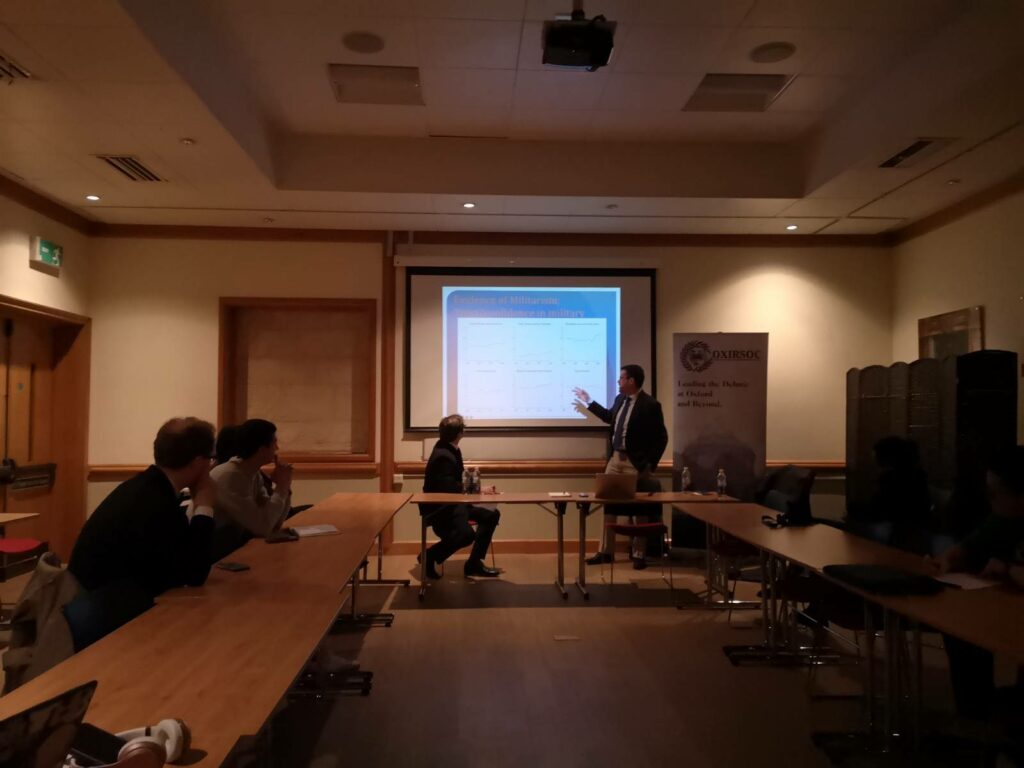Militarism is on the rise globally. Arms sales are at all-time highs, and public confidence in the military has surged. Rather than waning in the post-Cold War era, military glorification has intensified, with political and cultural leaders idealizing soldiers, not for their professionalism, but for their heroism and sacrifice.

At a recent event hosted by the #Oxford University International Relations Society, Professor Ron Krebs explored the proliferation of militarism, its cultural underpinnings, and its consequences for democracy, security, and governance. He painted a picture of a world where the military is increasingly romanticized, and political leaders use this veneration to their advantage.
Militarism is a cultural force, where militarism is often framed as a policy issue, whether states use excessive force or employ the military as a tool of national strategy. However, Krebs argues that militarism is, at its core, a set of cultural practices. It is driven by a deep-seated romanticism about the military, which manifests in three ways:
- Pacifist Militarism – Even among the left, there is a tendency to view the military as a necessary tool of national policy, even in peacetime.
- Excessive Force – The normalization of military interventions, where using force is seen as a default option rather than a last resort.
- Idealization of Soldiers – The emphasis on heroism and sacrifice overshadows discussions of military professionalism, effectiveness, or accountability.
This cultural shift is seen in the growing presence of the military in national celebrations, such as Independence Days. Military parades and displays have increased, yet there is little focus on mourning fallen soldiers. Instead, these events serve to reinforce the image of military power and national strength.
Why militarism has grown since the 1980, the decline of trust in government institutions, driven in part by #neoliberalism (the #deathcult), has paradoxically fuelled greater trust in the military. As faith in political leadership eroded, the military, seen as an aspirational and apolitical institution, became a pillar of stability.
This shift has created a dangerous dynamic:
- Populists thrive on military imagery. They love dressing up in military uniforms, invoking military rhetoric, and surrounding themselves with soldiers.
- Dead soldiers are useful political tools. They cannot challenge political narratives, making them perfect symbols for populist movements.
- Public perception of military support influences policy. When the public believes the military supports a political leader, they are more likely to support military action. This feedback loop drives increased militarization across the political spectrum.
The populist-military conflict, despite their public admiration for the military, many populist leaders privately clash with military institutions. Donald Trump, for instance, has reportedly expressed disdain for military leadership behind closed doors. His approach follows a broader pattern. Populists support enlisted soldiers while attacking military officers, particularly those from elite institutions like West Point. This allows them to position themselves as allies of “the people” while undermining traditional hierarchies.
In countries like Poland, Hungary, and India, populist leaders have avoided direct military confrontations, allowing dissenting officers to step aside quietly. In the United States, however, tensions are escalating. If military leaders resist political co-option, they will likely face aggressive purges and public attacks. Brazil under Bolsonaro offers a clear example. Although he had military ties, his alliances were fragile. When officers opposed his leadership, especially during the COVID-19 crisis, he swiftly removed them.
The long-term consequences, militarism is a raw deal. While it leads to increased military engagement, it does not necessarily bring greater benefits for soldiers. Instead, it results in, the erosion of democratic institutions. As militarism rises, civilian governance weakens, and leaders increasingly rely on military authority to consolidate power. Diminished military effectiveness. When the military becomes a political tool, its strategic competence declines.
Personal loyalty to leaders replaces merit, weakening the institution from within. A dangerous feedback loop. If unchecked, militarism becomes self-perpetuating, reinforced by political narratives, public perceptions, and the military’s own internal culture. The military, when it “drinks the Kool-Aid” of its own infallibility, loses its ability to self-correct. The blurring of lines between civilian leadership and military authority erodes trust, making governance more unstable and unpredictable.
Conclusion, we are living in an age of global militarism. The question is not whether it will wane on its own, it shows no signs of doing so. Instead, the challenge is how societies will respond to its continued rise. Will democratic institutions push back, ensuring that the military remains professional and accountable? Or will the glorification of soldiers, the erosion of civilian oversight, and the manipulation of military loyalty accelerate the militarization of politics? As Professor Krebs warns, the veneration of the military is not only about national security, it is about the future of democracy itself.
One thought on “The Age of Global Militarism: How Veneration of the Military Spread—and Why it Matters”